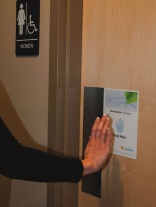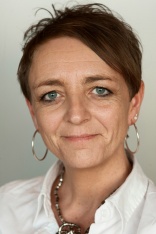Home › magazine › product features › Self cleaning touch points
Self-cleaning touch points
10th of July 2017How can frequently-touched surfaces such as washroom door handles be kept clean and germ-free at all times? The answer is to cover them with a self-cleaning “skin” according to NanoTouch Materials. Ann Laffeaty talks to the founders of the company behind this technology.
Sir Isaac Newton allegedly discovered the secret of gravity while under an apple tree. The structure of DNA was worked out by two men – Crick and Watson – when in a pub in Cambridge.
So when self-cleaning surfaces become the go-to solution in future years we may well look back on the place where they first began – in a Mexican restaurant in the US state of Virginia.
Mark Sisson and Dennis Hackemeyer, a pair of entrepreneurs who had been introduced to each other by friends, were glancing idly around the premises while having lunch back in 2012.
“We made some interesting observations,” said Sisson. “A young mother was wiping her table with a disinfectant wipe and then cleaning her toddler’s hands with a sanitiser. Meanwhile a waitress nearby was cleaning tables using what looked like a dirty dish cloth.
“We also watched a customer who was entering the restaurant sneeze into his hand just before opening the door. And when we visited the washroom we saw the floor was littered with paper towels, presumably discarded by people who had used them to touch the door handle.”
The two men were business associates who had been carrying out research into substrates and materials related to specialist printing processes. Their work in this field had introduced them to germ-killing technology based on embedding toxins in materials.
“It turned out that this approach to using toxins wasn’t what we ended up pursuing, but it got us thinking,” said Sisson.
A computer science graduate from Virginia Polytechnic Institute and State University, Sisson had been running his own advertising agency for some years. Hackemeyer was an economics graduate who had served for two years in the United States Marine Corps. This had involved training in the Nuclear-Biological-Chemical section – an interlude that provided an ideal background for the work the two men went on to carry out in the field of self-cleaning surfaces.
So, back to that lunch. The men came to some important conclusions after observing the practices of the waiting staff and their fellow diners. “First we realised that people are concerned about ‘clean’ for a good reason,” said Sisson. “But cleaning isn’t enough. You have to deliver a feeling of safety
and security by making ‘clean’ visible.
And the entire environment doesn’t have to be sterile: delivering a visibly clean surface exactly when and where it is needed is the ultimate goal...a rifle shot approach, if you like.”
Any surface that is likely to be touched by people – or where personal items may be put down – needs to be kept clean, says Sisson. So the two men embarked on a quest to deliver clean surfaces in those frequently-touched areas.
They spent years working with specialists in the fields of materials science, nanotechnology and advanced manufacturing before developing their range of NanoSeptic skins. These are said to be capable of killing bacteria, viruses and fungi on an ongoing basis without the use of chemicals, diluted poisons or heavy metals. Made from a durable polyester-coated fabric, they have an adhesive
backing that is said to adhere to most surfaces and leave virtually no residue behind when removed.
Powered by light
So how do they work? “They are powered by light and use mineral nanocrystals to create an oxidation reaction that is stronger than bleach,” said Sisson. “This means that the surface continually oxidises organic contaminants.
“They also have the ability to work 24/7 since the oxidation reaction is powered by any visible light. This includes incandescent, fluorescent and LED light while the nanocrystals generate a strong static effect at a microscopic scale to trap organic contaminants even in the absence of light.”
Before the first Nano Septic products were launched on to the market, extensive studies were carried out in order to verify that they actually worked.
“Our products went through a nine-month vetting process by a board of university scientists,” said Sisson. “All testing took place at an FDA/EPA-compliant independent laboratory using a variety of protocols including the JIS 2801 test for antimicrobial efficacy.
“Meanwhile our overseas distributors have conducted their own tests in order to satisfy specific regulatory requirements. Organisations that have independently verified our efficacy overseas include the Korea Research Institute and the King Abdulaziz Research Hospital in Saudi Arabia.”
In Saudi Arabia testing was carried out against a strain of the Coronavirus that has been the cause of the MERS outbreak. A million of the virus cells were introduced on to a Nano-Septic surface during the tests. These were wiped out in under 30 minutes.
Specific sectors
In 2015 NanoTouch Materials was awarded a three-year US $2 million research and development grant to enable the company to improve efficacy and durability; to conduct additional product development for specific industry sectors and to carry out market research to gauge consumer perception of self-cleaning surfaces.
NanoSeptic skins are a world first according to creators Sisson and Hackemeyer. “We believe we are the only company on the market to be manufacturing this type of self-cleaning surface for use on facility touch points and portable applications,” said Hackemeyer. “We have seen attempts to create surfaces embedded with toxins such as Triclosan, which has now been banned by the EPA. However that approach involves killing germs using poisons. Part of our mission was to use technology in the place of toxins.”
He admits that NanoSeptic surfaces share some technology with other products such as self-cleaning coatings for glass and building exteriors. “However the main aim of those applications is to minimise the quantity of pollution residue on building exteriors or to reduce the frequency of cleaning solar panels,” said Hackemeyer. “Our surfaces are designed to break down the organic contaminants that are deposited by human touch.”
Most NanoSeptic surface surfaces will last up to 12 months though in particularly high traffic areas the skins might need to be replaced more frequently, typically every 30-90 days. The skins work best on flat, tubular and uniform surfaces and are currently available in the form of self-cleaning skins for door handles plus portable mats for use on counters, tray tables and bathroom vanity units.
Other product claims
Over recent years there have been a number of other products claimed by the manufacturers to be “self-cleaning” introduced on to the market. Earlier this year a company called Vioguard launched a computer keyboard that comes with its own self-cleaning case. Aimed at the healthcare sector, the keyboard can be sent back into its case at the touch of a button where a type of ultra-violet light is said to kill 99.99 per cent of bacteria and pathogens within 90 seconds.
Meanwhile a sports bag made by Paqsule is claimed to be able to sanitise gym clothes, again using ultra-violet light. The battery-powered duffel bag works by converting the oxygen inside the bag into activated oxygen while an ultra-violet light sanitises the items of clothing.
Other companies offer more broad-spectrum anti-microbial solutions to provide cleaner facilities. But the NanoTouch team takes issue with this approach. “By trying to kill all microbes, the good microorganisms in our environment are destroyed along with the bad,” said Hackemeyer. “Our goal isn’t to create a sterile world: it’s to create a cleaner, greener world.”
And he adds that Nano-Septic surfaces offer further benefits to the customer. Besides delivering hygiene, they also reassure anyone using the facility that frequently-touched surfaces are constantly being sanitised. The germ-killing skins are branded with the Nano-Septic name so that people touching the surface knows they can do so safely. And this in turn enhances the image of the FM services provider, says Hackemeyer.
“We originally developed these surfaces for hospitals since we felt their value would be to provide cleaner healthcare facilities,” he said. “However we quickly received enquiries from facility managers and commercial cleaners who saw our products as a way of improving the perception of their value.
“Suddenly they were able to make ‘clean’ actually visible to their customers and tenants while also providing a truly cleaner environment.”
And the surfaces can be used practically anywhere, he says. “I really can’t think of a facility where the employees and guests wouldn’t want cleaner touch points,” said Hackemeyer. “Whether you’re a physician wanting to improve the patient experience or a school seeking to positively influence the perception of parents, NanoSeptic surfaces help to deliver that value.”
For more information, go to: www.nanotouchmaterials.com










